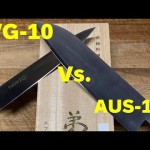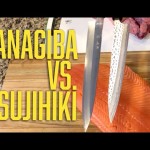When it comes to kitchen knives, there are many different types to choose from. Two of the most popular are the Santoku and the Chef Knife. Both knives have their own unique advantages and disadvantages, so it can be difficult to decide which one is best for you. In this article, we will compare the Santoku and Chef Knife to help you decide which one is the right choice for your kitchen. We will look at the design, features, and performance of each knife to help you make an informed decision.
Do you need a santoku knife and Chef Knife
When it comes to kitchen knives, there are two essential knives that every home cook should have: a santoku knife and a chef knife. Both knives are versatile and can be used for a variety of tasks, but they have different strengths and weaknesses. Knowing which knife to use for which task can help you become a better cook and make meal preparation easier.
Santoku Knife
A santoku knife is a Japanese-style knife that is typically shorter and lighter than a chef knife. It has a wide blade with a flat edge and a sheepsfoot blade shape. The blade is usually between 5 and 7 inches long. Santoku knives are great for slicing, dicing, and mincing vegetables, as well as for cutting meat and fish. They are also great for chopping herbs and nuts.
Chef Knife
A chef knife is a larger, heavier knife that is typically 8 to 10 inches long. It has a curved blade with a pointed tip and a sharp edge. Chef knives are great for slicing, dicing, and mincing larger pieces of food, such as large vegetables, fruits, and meats. They are also great for chopping through bones and tougher cuts of meat.
Which Knife Should You Use?
When it comes to choosing between a santoku knife and a chef knife, it really depends on the task at hand. If you are cutting smaller pieces of food, such as vegetables and herbs, then a santoku knife is the better choice. If you are cutting larger pieces of food, such as fruits and meats, then a chef knife is the better choice. Both knives are essential for any home cook, so it is important to have both on hand.
Which type of kitchen knife is safer to use
When it comes to kitchen knives, safety is a top priority. The right knife can make all the difference in the kitchen, but it’s important to choose the right type of knife for the job. There are a few different types of kitchen knives, each with its own advantages and disadvantages.
Serrated knives are a popular choice for many kitchen tasks. They are designed with a saw-like edge that makes them ideal for slicing through tough foods like bread and tomatoes. The serrated edge also helps to reduce the risk of slipping and cutting yourself. However, serrated knives can be difficult to sharpen and can cause more damage to the food than other types of knives.
Straight-edge knives are the most common type of kitchen knife. They are designed with a single, straight edge that is perfect for slicing and chopping. Straight-edge knives are easy to sharpen and can be used for a variety of tasks. However, they can be more dangerous than other types of knives because they require more precision and can cause more serious cuts if not used properly.
Paring knives are smaller than other types of kitchen knives and are designed for more delicate tasks. They are perfect for peeling and slicing fruits and vegetables. Paring knives are usually safer to use than other types of knives because they are smaller and require less force to use. However, they can be difficult to control and can cause more serious cuts if not used properly.
Utility knives are a versatile type of kitchen knife that can be used for a variety of tasks. They are designed with a curved blade that makes them ideal for slicing and chopping. Utility knives are usually safer to use than other types of knives because they require less force and are easier to control. However, they can be difficult to sharpen and can cause more damage to the food than other types of knives.
When it comes to choosing the right type of kitchen knife, it’s important to consider the task at hand and the level of safety you need. Serrated knives are great for slicing through tough foods, while straight-edge knives are perfect for chopping and slicing. Paring knives are ideal for delicate tasks, while utility knives are a versatile choice for a variety of tasks. No matter which type of knife you choose, it’s important to use it safely and properly.
What is santoku knife best for
The santoku knife is a versatile kitchen tool that is becoming increasingly popular in home kitchens. It is a Japanese-style knife that is shorter and lighter than a traditional chef’s knife, and it has a flat blade with a curved tip. The santoku knife is great for a variety of tasks, from slicing and dicing vegetables to mincing herbs and chopping nuts. It is also well-suited for cutting through tougher meats and fish.
The santoku knife is a great all-purpose knife that can be used for a variety of tasks. It is perfect for slicing and dicing vegetables, mincing herbs, and chopping nuts. It is also great for cutting through tougher meats and fish. The santoku knife is also well-suited for making thin, precise cuts, such as julienne or brunoise. The flat blade and curved tip make it easy to make thin, precise cuts.
The santoku knife is also great for making thin, precise cuts, such as julienne or brunoise. The flat blade and curved tip make it easy to make thin, precise cuts. The santoku knife is also well-suited for making thin, precise cuts, such as julienne or brunoise. The santoku knife is also great for making thin, precise cuts, such as julienne or brunoise.
The santoku knife is a great all-purpose knife that can be used for a variety of tasks. It is perfect for slicing and dicing vegetables, mincing herbs, and chopping nuts. It is also great for cutting through tougher meats and fish. The santoku knife is also well-suited for making thin, precise cuts, such as julienne or brunoise. The flat blade and curved tip make it easy to make thin, precise cuts.
The santoku knife is a great choice for home cooks who want a versatile knife that can handle a variety of tasks. It is lightweight and easy to use, and it is perfect for slicing, dicing, mincing, and chopping. The santoku knife is also great for making thin, precise cuts, such as julienne or brunoise. The flat blade and curved tip make it easy to make thin, precise cuts.
The santoku knife is a great all-purpose knife that can be used for a variety of tasks. It is perfect for slicing and dicing vegetables, mincing herbs, and chopping nuts. It is also great for cutting through tougher meats and fish. The santoku knife is also well-suited for making thin, precise cuts, such as julienne or brunoise. The flat blade and curved tip make it easy to make thin, precise cuts.
What is the difference between Santoku and chef’s knife
The Santoku and chef’s knife are two of the most popular and versatile knives used in the kitchen. Both knives are used for a variety of tasks, from slicing and dicing to mincing and chopping. But there are some key differences between the two that make them better suited for certain tasks.
Size is one of the main differences between a Santoku and a chef’s knife. The Santoku is typically shorter and lighter than a chef’s knife, making it easier to maneuver and control. The Santoku is usually between 5 and 7 inches in length, while a chef’s knife can range from 8 to 10 inches.
Shape is another key difference between the two knives. The Santoku has a flatter blade than a chef’s knife, which makes it better for slicing and chopping. The chef’s knife has a curved blade, which is better for rocking and chopping. The Santoku also has a hollow edge, which helps to reduce friction and make slicing easier.
Uses are also different between the two knives. The Santoku is better suited for slicing and chopping vegetables, while the chef’s knife is better for cutting through tougher items like meats and bones. The Santoku is also great for making thin, precise cuts, while the chef’s knife is better for larger, rougher cuts.
In conclusion, the Santoku and chef’s knife are both great tools for the kitchen. While they both have their uses, they are best suited for different tasks. The Santoku is better for slicing and chopping vegetables, while the chef’s knife is better for tougher items like meats and bones. Knowing the differences between the two knives can help you choose the right one for the job.
We hope this article has helped you decide which knife is best for you. Whether you choose a Santoku or a Chef Knife, we wish you the best of luck in your culinary endeavors. Goodbye and happy cooking!














